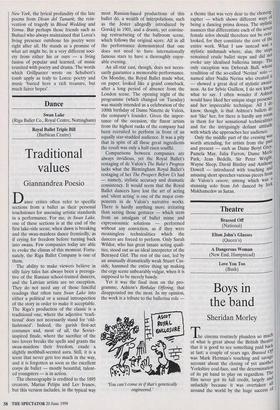Dance
Swan Lake (Riga Ballet Co., Royal Centre, Nottingham)
Traditional values
Giannandrea Poesio
Dance critics often refer to specific sections from a ballet as their personal touchstones for assessing artistic standards in a performance. For me, in Swan Lake, one of these sections is at the end of the first lake-side scene, when dawn is breaking and the swan-maidens dance frenziedly, as if crying for freedom before turning back into swans. Few companies today are able to evoke the climax of this moment. Fortu- nately, the Riga Ballet Company is one of them.
The ability to make viewers believe in silly fairy tales has always been a preroga- tive of the Russian school-trained dancers, and the Latvian artists are no exception. They do not need any of those fanciful readings that often turn Swan Lake into either a political or a sexual introspection of the story in order to make it acceptable. The Riga's production of the classic is a traditional one, where the adjective 'tradi- tional' does not necessarily stand for 'old- fashioned'. Indeed, the garish first-act costumes and, most of all, the Soviet- inspired finale, where the sacrifice of the two lovers breaks the spells and grants the swan-maidens their freedom, exude a slightly mothball-scented aura. Still, it is a scent that never gets too much in the way, and it is forgotten as soon as the excellent corps de ballet — mostly beautiful, talent- ed youngsters — is in action.
The choreography is credited to the 1895 creators, Marius Petipa and Lev Ivanov, but this version includes, in the typical way most Russian-based productions of this ballet do, a wealth of interpolations, such as the Jester allegedly introduced by Gorskij in 1901, and a drastic, yet convinc- ing restructuring of the ballroom scene, which follows the original score. All in all the performance demonstrated that one does not need to have internationally famous stars to have a thoroughly enjoy- able evening.
An all-star cast, though, does not neces- sarily guarantee a memorable performance. On Monday, the Royal Ballet made what, on paper, looked like a grand comeback, after a long period of absence from the London scene. The opening night of the programme (which changed on Tuesday) was mainly intended as a celebration of the 100th birthday of Dame Ninette de Valois, the company's founder. Given the impor- tance of the occasion, the finest artists from the highest ranks of the company had been recruited to perform in front of an equally star-studded audience. It was a pity that in spite of all these great ingredients the result was only a half-risen soufflé.
Comparisons between companies are always invidious, yet the Royal Ballet's restaging of de Valois's The Rake's Progress lacks what the Birmingham Royal Ballet's restaging of her The Prospect Before Us had — namely, stylistic accuracy and dramatic consistency. It would seem that the Royal Ballet dancers have lost the art of acting and 'silent acting' is one of the major com- ponents in de Valois's narrative works. There is hardly anything more irritating than seeing those gestures — which stem from an amalgam of ballet mime and expressionistic solutions — performed without any conviction, as if they were meaningless technicalities which the dancers are forced to perform. Only Sarah Wildor, who has great innate acting quali- ties, stood out as an ideal interpreter of the Betrayed Girl. The rest of the cast, led by an unusually dramatically weak Stuart Cas- sidy, hammed the entire thing up making the orgy scene unbearably vulgar, when it is supposed to be merely bawdy.
Yet it was the final item on the pro- gramme, Ashton's Birthday Offering, that disappointed me the most. In my opinion, the work is a tribute to the ballerina role — `You can't come in if that's genetically engineered.' a theme that was very dear to the choreog- rapher — which shows different ways of being a dancing prima donna. The stylistic nuances that differentiate each of the seven female solos should therefore not be over- looked, for they constitute the core of the entire work. What I saw instead was stylistic mishmash where, alas, the steps remained crude ballet steps and did net evoke any idealised ballerina image. The only exception was Deborah Bull, whose rendition of the so-called `Nerina' solo named after Nadia Nerina who created it — showed a great deal of stylistic aware- ness. As for Sylvie Guillem, I do not know what to say. I often wonder if Ashton would have liked her unique stage presence and her impeccable technique. All I 11° know, though, is that Ashton's ballets do not 'like' her, for there is hardly any room in them for her sensational technicalities and for the intriguingly defiant attitude with which she approaches her audience. Only the middle part of the evening was worth attending, for artists from the past and present — such as Dame Beryl Grey, Pamela May, Julia Farron, Dame Merle Park, Jean Bedells, Sir Peter Wright, Wayne Sleep, David Bintley and Anthony Dowell — introduced with touching and amusing short speeches various pieces from de Valois's oeuvre, among which was a stunning solo from Job danced by Irek Mukhamedov as Satan.


























































 Previous page
Previous page